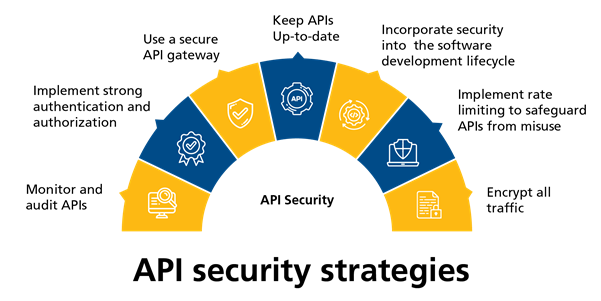Top 7 API Security Strategies to Protect Your APIs
Application Programming Interfaces (APIs) have become increasingly important today. They help organizations to seamlessly integrate their products with third-party applications, mobile devices, and the Internet of Things (IoTs). With release cycles getting shorter, APIs have become the backbone for automation, helping quicken the entire software development lifecycle. This has led organizations to focus extensively on APIs that provide great customer experiences.
However, establishing trust with customers takes time and effort, which can be easily shattered with just one data breach. Additionally, with the increasing adoption of APIs, security risks such as unauthorized access, SQL injection attack, and denial of service attacks also increase. Therefore, implementing a comprehensive API security strategy is a necessity for IT teams. API security strategy is a set of practices, processes, and tools that enable businesses to manage their APIs more securely and efficiently.

Figure 1 ─ API security strategies
Here are a few security-related best practices to enhance the security of your API.
1. Use a secure API gateway
An API gateway is a single entry point for all traffic into a cluster, a data center, or a group of distributed services. It receives requests from clients and directs them to the relevant services, apart from enforcing security policies, rate limit requests, and log activity.
To choose a secure API gateway, make sure to look for the following features:
- Authentication – The ability to authenticate users and clients before they can access the API.
- Authorization – The ability to control what users and clients can do with the API.
- Rate limiting – The ability to limit the number of requests that can be made to the API per second or minute.
- Logging – The ability to log all API requests and responses.
Several API gateways are available in the market, such as IBM API Connect, Apigee, and Mulesoft API Gateway, all of which are secure options.
2. Implement strong authentication and authorization
When implementing authentication and authorization for APIs, following the principle of least privilege is important. This means users should only be granted only the necessary access to do their job.
Several different authentication and authorization methods can be used for APIs, such as:
- Basic authentication – This method uses a username and password to authenticate users.
- OAuth 2.0– This is a more secure authentication method that uses tokens to grant access to APIs.
- OpenID Connect (OIDC) – OIDC is an identity layer built on OAuth 2.0 that provides a standardized framework for user authentication. This method enables users to authenticate themselves through an identity provider, who then provides a token to the client application.
- JSON Web Tokens(JWT)– JWT refers to an open standard that securely transmits information between parties as a JSON object. The method enables users to verify their identities and grant permission to access secure resources by exchanging small, self-contained tokens.
- Access control – APIs should use Role-Based Access Control (RBAC) to authorize access based on a user’s role.
3. Encrypt all traffic
All API traffic should be encrypted, both in transit and at rest. This helps to protect sensitive data from being intercepted by unauthorized parties.
There are several different ways to encrypt API traffic, such as:
- Transport Layer Security(TLS) – This cryptographic protocol is used to secure communication over the Internet for various applications, including web browsing, email, instant messaging, and Voice over Internet Protocol (VoIP). TLS encrypts all traffic between a client and server, including the URL, headers, and body of the request.
- Data at rest encryption – This is a method of encrypting data stored on a disk such as a hard drive or a tape. This security measure ensures that if someone gains physical access to the device, they won’t be able to read the data.
4. Use a secure development process
Developers should follow secure coding practices when developing APIs, which helps prevent common security vulnerabilities like Structured Query Language (SQL) injection and Cross-Site Scripting (XSS).
This refers to items such as:
- Using strong passwords – Developers should use strong passwords for all API accounts. This includes passwords for API keys, database accounts, and other sensitive resources.
- Avoid SQL injection – SQL injection is an attack that can be used to steal data from a database. Developers can avoid SQL injection by using prepared statements or parameterized queries.
- Sanitize user input – The user input should always be sanitized before it is used in an API. By doing this, XSS attacks that introduce malicious code into a web page or API are less likely to occur.
- Use secure coding frameworks and libraries–There are several secure coding frameworks and libraries available that can help developers to write more secure code.
5. Use rate limiting
Rate limiting defines the number of requests that can be made to an API within a specified period. This helps to prevent attackers from flooding an API with recommendations, which can cause the API to become unavailable or overloaded.
There are several different ways to implement rate limiting as below:
- A rate limiter middleware – This is a piece of software that is incorporated in front of an API and enforces rate limits, e.g., IBM DataPower.
- A cloud-based rate-limiting service – This is a service that provides rate-limiting functionality as a service.
6. Monitor and audit APIs
By monitoring APIs, one can identify potential attacks and take steps to mitigate them.
There are several different ways to monitor APIs for suspicious activity, as below:
- Security monitoring tool – A security monitoring tool is a piece of software that can be used to collect and analyze data from your APIs.
- Use API analytics tools – These tools can provide real-time visibility into API usage and traffic patterns, making it easier to detect anomalies or unusual behaviour. Example Google Cloud Endpoints, Apigee
- Set up alerts – set up alerts for any suspicious activity, such as a sudden spike in traffic or repeated failed authentication attempts. Alerts can help you quickly respond to potential threats and prevent further damage.
7. Keep APIs up-to-date
By keeping your APIs up to date, one can ensure that they are patched for security vulnerabilities.
Here are some best practices for keeping your APIs up-to-date:
- Use a Continuous Integration (CI/) Continuous Deployment (CD) pipeline – A CI/CD pipeline can help the process of building, testing, and deploying a code. This can help ensure that the APIs are always up-to-date.
- Patch security vulnerabilities promptly – When a security vulnerability is discovered, it should be patched up promptly, thus helping protect from attacks that exploit this vulnerability.
Conclusion
Looking ahead, the landscape of API security is bound to evolve rapidly. As time passes, we can expect to see an increase in the utilization of Artificial Intelligence (AI) and Machine Learning (ML) for the purpose of detecting and preventing potential threats. Automating tasks like vulnerability scanning and incident response can help organizations streamline their operations and quickly respond to security events.
In conclusion, API security is an ongoing journey, not a one-time destination. As the API landscape evolves, a proactive and adaptive approach to security will be key to ensuring a resilient and secure API ecosystem.
Latest Blogs
Core banking platforms like Temenos Transact, FIS® Systematics, Fiserv DNA, Thought Machine,…
We are at a turning point for healthcare. The complexity of healthcare systems, strict regulations,…
Clinical trials evaluate the efficacy and safety of a new drug before it comes into the market.…
Introduction In the upstream oil and gas industry, drilling each well is a high-cost, high-risk…




